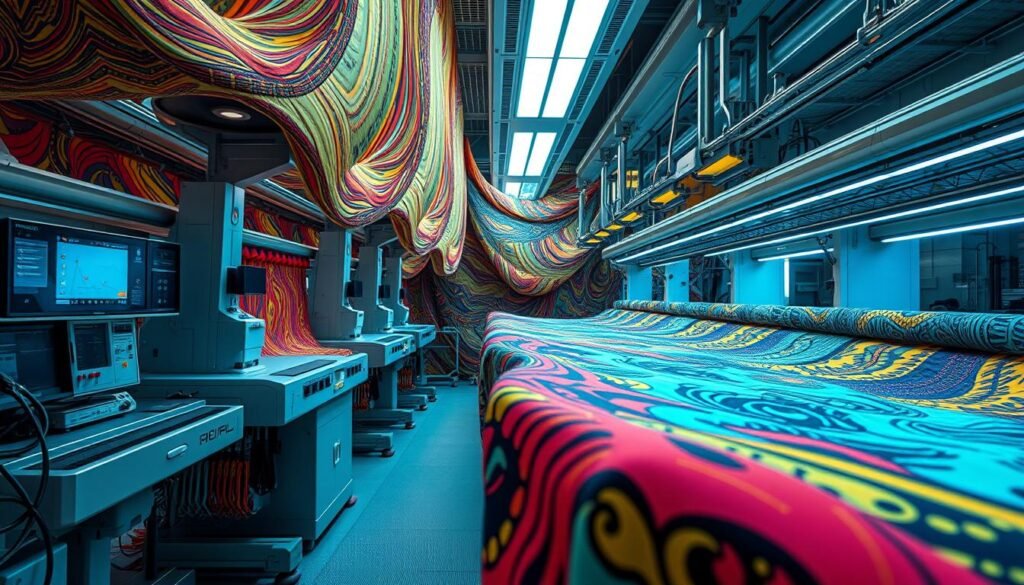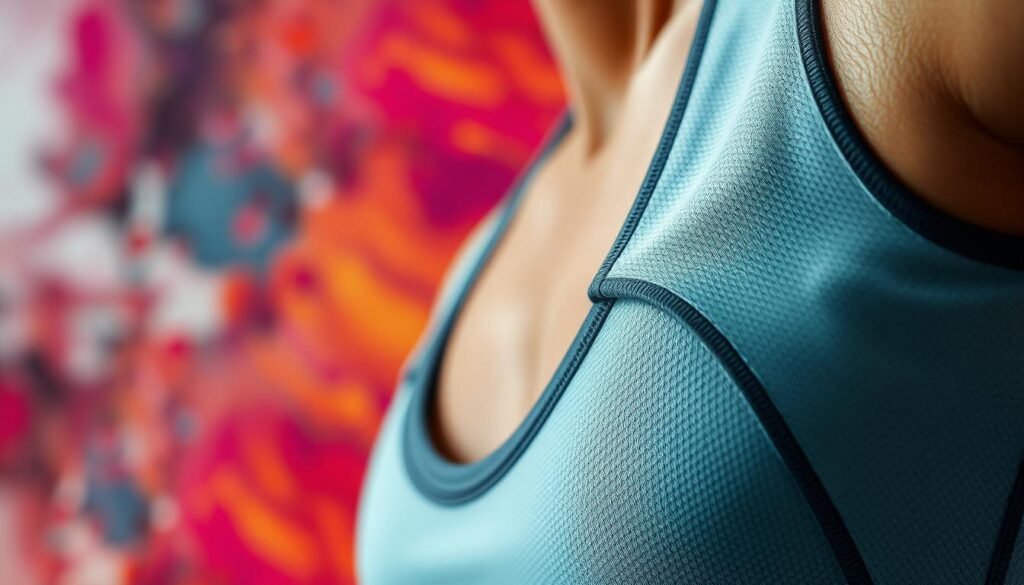Ralph Lauren believed fashion is more than brands or labels. It reflects our inner selves through comfort and confidence. In fabric technology, there’s a quest for materials that not only look good but feel like a second skin. 4-way stretch fabrics stand out, merging comfort with design in clothing.
These fabrics bring freedom of movement, fitting the body as if tailor-made. They changed the game in clothing design. They’re perfect for everything from sports clothes to some formal wear, mixing elasticity, performance, and style. 4-way stretch materials are now key in fashion, meeting a demand for clothes that are both functional and stylish12.
Key Takeaways
- 4-way stretch fabrics herald a new era in fabric technology, where comfort meets agility1.
- Textile science innovations allow for stretchy materials that enhance clothing fit and overall apparel comfort.
- The integration of Spandex and Lycra has been pivotal in the creation of modern stretch fabrics, significantly expanding design possibilities2.
- Performance and durability in clothing design are markedly improved by the resilience of 4-way stretch material.
- Activewear has been transformed by the functional yet fashionable capabilities of stretch fabrics, becoming a staple in sportswear and beyond12.
Introduction to Stretchy Fabrics in Clothing Technology
Stretchy fabrics have changed how we make and wear clothes. DuPont invented these materials in the 1960s. They can stretch a lot but still keep their shape3. First used in swimwear and bras, they soon helped athletes with their stretchiness and knit design3.
In the 1980s, stretchy fabrics became popular in everyday fashion. Now, they improve the look and feel of clothes. They’re key in making better textiles with benefits like letting skin breathe, blocking UV rays, and stopping microbes, perfect for daily and sports wear4.
Today’s stretch fabrics, like those with spandex, can stretch four times their size. Mixed with polyester or cotton, they give a 20% stretch, making clothes more comfortable and functional3. This matches the demand for clothes that look good, feel comfy, and perform well4.
The focus on green practices has brought eco-friendly stretchy materials. Using recycled stuff and cutting waste helps the planet. Yet, the quality and function of the materials remain top-notch4.
The stretch fabric market is growing globally, thanks to ongoing innovation. Pine Crest Fabrics, since 1978, leads in various stretch materials. Their work shows how stretch fabrics have many uses, from fashion to industry3.
| Fabric Type | Description | Common Uses |
|---|---|---|
| Spandex Blends | Can stretch up to 400% without losing form | Sportswear, Undergarments |
| Neoprene Rubber | Synthetic polymer with high flexibility and water resistance | Bodysuits, Fashion Pieces |
| Recycled Polyester | Eco-friendly, incorporating benefits such as reduced waste | Active and Casual Wear |
The future of stretchy materials in clothing looks bright and endless4.
Exploring the Composition of 4-Way Stretch Fabrics
The unique appeal of 4-way stretch fabric is its ability to stretch both ways. This makes clothes more elastic and comfortable. The fabric stretches in all directions, ensuring a perfect fit. It also keeps the garment’s shape after many wears.
4-way stretch fabrics are mainly made of elastane fibers, which are super stretchy. When blended with materials like cotton, polyester, and nylon, they create flexible fabrics. This structure helps clothes offer unbeatable comfort and freedom of movement, perfect for both activewear and everyday outfits.
| Fabric Type | Stretch Percentage | Typical Use |
|---|---|---|
| Modern Jersey | ≥ 25% Horizontal, < 25% Vertical | Casual and Fashion Apparel |
| Sport Lycra | ≥ 50% Horizontal, ≥ 25% Vertical | Athletic and Performance Wear |
| Cotton Spandex Jersey | ≥ 50% Horizontal, ≥ 50% Vertical | Flexible Everyday Clothing |
Choosing 4-way stretch fabric boosts the quality of clothes. Clothes keep looking good and working well after lots of uses and washes. The fashion world loves this fabric for its tech benefits and its fit on different body shapes. This makes clothes more inclusive and stylish.
These fabrics are everywhere – in sportswear, high-fashion, and daily wear. They’re essential in today’s and tomorrow’s fashion world51.
The mix of practical advantages and the high demand for durable, comfy, stylish materials drives research into better 4-way stretch fabrics.
Custom Fabric and Its Transformative Impact on Activewear Design
The evolution of custom fabric has greatly shaped activewear innovation. It offers more than looks — it enhances sports apparel’s functionality. This change meets the rising need for personalized, high-performance wear. Thus, the industry is now filled with options that focus on individual athletic needs and comfort.
The Emergence of Custom Fabric in Athletic Gear
Custom fabrics are setting new norms for activewear. They bring flexibility and strength fit for various sports, aiding top performance and comfort. The sports clothing market, with a future value of USD $475 billion by 2034, shows how transformative textiles are key6.
Advancements in Custom Fabric Enhancing Athletic Performance
Modern custom fabric improvements have led to features like 4-way stretch and moisture control. These are essential for comfort and efficiency during tough exercises. COOLMAX’s special polyester fabrics keep athletes cool and dry, changing the way fabrics work with the body6.
Customization Leading to Inclusive and Personalized Apparel
The use of custom fabric in sports gear now emphasizes inclusivity and personalization. Designers can make outfits for different bodies and needs, ensuring everyone gets quality gear. This move to tailored design is boosted by technologies like ChromoINK’s digital inks, which ensure prints are bright, long-lasting, and keep the fabric comfortable and breathable.
Technological Progress in Fabric Stretchability and Recovery
Textile engineering is reshaping the world of fabric stretchability and recovery. Now, materials bounce back to their original shape after being stretched. This change is huge for activewear. It means clothes keep their shape and perform well, even after many washes and wears.
There’s now fabric that can stretch up to 67% and still conduct electricity, ideal for active use7. These advances show how fabric tech is combining function with eco-friendly practices. This is crucial in today’s world, where caring for the planet matters a lot.
Brands are also introducing sustainable fabrics, like Nullarbor Fibre™, made without plants. This reduces land, water, and energy needs during its quick 18-day production8. Plus, Teijin Frontier’s linen-like polyester feels natural but is easier to care for8.

Technology like DriTan™ by ECCO Leather is making textiles stronger. It saves 20 liters of water for each piece of leather made. This shows a move toward more eco-friendly methods in textile engineering8.
Omni-Heat™ 3D Thermal Reflective fabrics by Columbia Sportswear show how thermal tech has advanced. They’re making fabrics that keep you warmer and more comfortable in all types of weather8.
The progress in fabric stretchability, recovery, and eco-friendliness marks a new era. Textile engineering is now focusing on high performance and lowering environmental impact. This approach fits well with worldwide efforts to be more sustainable.
The Role of Spandex and Lycra in Modern Textiles
Spandex and lycra have brought a big change to clothing design. They are known for being super stretchy and strong. This has made them key in making clothes that are both functional and comfy.
Spandex was first called “Fiber K.” It can stretch up to five times its size. This makes it great for all kinds of clothes9. Most spandex is made by a method called solution dry spinning. This method is used for about 90% of its production globally9. The success of this method shows how much the fabric is liked and used in the fashion world9.
Discovery and Integration of Spandex into the Fabric Industry
Spandex is not only used in clothes. It’s also used in the car industry, like in door panels9. This shows how versatile spandex is, being used in different industries, including medical and household items9.
Lycra’s Contribution to Enhanced Fabric Elasticity
Lycra has also changed the textile industry with its amazing stretchiness. It can stretch up to five times its original size and still keep its shape10. This quality has made it very popular in activewear and swimwear. Digital printing has made lycra even more appealing. It allows for detailed designs and bright colors that stay even after many washes10.
Comparing Properties of Spandex and Lycra in Clothing
| Property | Spandex | Lycra |
|---|---|---|
| Elasticity | Extends up to 500% | Extends up to 600% |
| Popular Use | Athletic and casual apparel, industrial applications | High-performance sports and entertainment apparel |
| Manufacturing | Solution dry spinning method | Advanced digital printing and sustainable materials |
| Market Demand | Increasing demand in various sectors | High demand in fashion and performance gear sectors |
Both spandex and lycra will keep playing a big role in the world of textiles. They make clothes more flexible and comfortable all over the world910.
Improving Comfort and Fit with Moisture-Wicking Technologies
Moisture-wicking technology is a big plus in active clothing, making them more comfortable and better performing. It uses special fibers, like polyester and nylon, to draw moisture away from the skin. Then, it moves this moisture to the surface where it evaporates quickly. This keeps the person wearing the clothes dry and cool, even when they’re working out hard. It helps them stay comfortable and efficient.
The Science of Moisture-Wicking in Active Garments
Thanks to advanced textile engineering, moisture-wicking fabrics are more breathable and dry faster than old-fashion materials. This is super helpful for workout clothes, as it keeps moisture well-managed. Adding mesh panels increases the fabric’s breathability, particularly in areas that sweat a lot. This makes the clothes more comfortable when exercising a lot11.

Advantages of Polyester and Its Hygroscopic Qualities
Polyester blends are top choices for workout clothes because they’re tough and great at managing moisture. Polyester’s ability to absorb moisture helps it wick away sweat, dry quickly, and resist wrinkles. So, for anyone looking for sportswear that keeps up with them, Polyester is the way to go1211.
Environmental Benefits of Recycled Polyester Fabrics
Using recycled polyester doesn’t just keep up the performance of traditional polyester; it’s also better for the planet. It turns plastic bottles into high-quality fibers, cutting down on landfill waste and saving energy. While there are still hurdles like color choices, recycled polyester for active wear is a win-win. It supports a healthier environment without losing out on quality or style.
Moisture-wicking technology isn’t just about keeping comfy. It also helps our planet by improving how we make clothes. It meets both our need for good performance wear and our wish to be more eco-friendly. A great step forward in making better, sustainable clothes.
Revolutionizing the Athleisure Trend with High-Performance Fabrics
High-performance fabrics are blending stylish comfort with innovation, reinventing the athleisure trend. The sportswear market is growing fast. These materials mix beauty with improving how we feel when we wear them.
By 2024, sportswear will evolve with fabrics that track health data through sensors13. These changes, along with a boost in demand for personalized sportswear, reflect individual style and comfort needs13. Consumers now prefer sportswear tailored to their unique requirements.
Eco-friendly materials are becoming popular in custom apparel, making a mark. Using organic cotton, bamboo, and recycled polyester marries stylish comfort with caring for our planet14. These eco-conscious choices drive the trend towards sustainable and ethical sportswear14.
| Year | Global Sportswear Market Value | Compound Annual Growth Rate |
|---|---|---|
| 2020 | $161 billion15 | |
| 2030 (Est.) | $64.39 billion growth in Sports Textiles15 | 4.7%15 |
High-performance fabrics offer features like moisture control and UV protection14. These advances make athleisure perfect for exercise and daily wear.
The US and other countries see strong growth in sportswear markets1513. More women wearing sports outfits and e-commerce options fuel this trend13. It’s easier now to find athleisure that fits personal style13.
Athleisure, pushed by high-performance fabrics, meets today’s lifestyle needs. It leads the way to more innovation and inclusivity in fashion.
Stretch Fibers: Combining Aesthetics with Functionality for All-day Wear
Adding stretch fibers like elastane and Lycra has changed fashion for the better. These fabrics keep clothes looking good and feeling comfy all day. They help clothes keep their shape and support without losing comfort.
How Elastane and Spandex Enhance Everyday Fashion
Elastane, also known as spandex, makes clothes stretchy and durable. This means you can move easily, which is perfect for today’s lifestyle. It satisfies the need for both casual and work outfits.
Fusing Style and Performance in Stretch Fabric Design
Stretch fibers work well with lots of other fabrics, letting designers create clothes that look and perform great. For example, sublimation printing adds beauty without affecting the fabric’s stretch. This shows how fabric design is getting more innovative.
Performance fabrics use stretch fibers to set new fashion trends that focus on lasting, doing their job well, and looking good1617. They’re mainly made of synthetic fibers like nylon and polyester. These materials keep you dry and wrinkle-free, making them great for both sporty and relaxing outfits16. Stretch fabrics also include power mesh. This adds support and shape to clothes without feeling too tight, making them comfy for wearing all day17.
| Fiber Type | Properties | Common Uses |
|---|---|---|
| Polyester Blends | Moisture-wicking, quick-drying, durable | Activewear, sportswear |
| Nylon | Strong, abrasion-resistant, moisture-wicking | Outdoor apparel, sportswear |
| Merino Wool | Temperature-regulating, odor-resistant | Performance wear, casual |
In conclusion, stretch fibers are making a big difference in how we make clothes. They generate garments that don’t make you choose between looking good, feeling comfortable, or working well. This progress is key to creating modern fabrics that fit our active lives while also being sustainable and innovative16.
Future Developments: Innovating Beyond Conventional Stretch Materials
The world of activewear is entering a new phase. It’s moving past old limits thanks to innovations in fabrics. The mix of fabric innovation, smart stretch textiles, and wearable technology will change how future outfits look and work.
Predicting Trends: Smart Fabrics and Wearable Technology in Clothing
Smart textiles are pushing fashion into a new age. Clothes will do more than look good and feel comfortable. They’ll be part of our digital world. Smart stretch textiles will bring unmatched flexibility and a way to connect with gadgets and track health stats.
They’re making responsive fabrics that react to different situations18. Clothes will have tiny electronic parts. This allows for cool inventions like clothes that change warmth with the weather18.
Biomechanics and Material Engineering: The Next Generation of Activewear
Material engineering and biomechanics are changing activewear’s creation. Future sportswear will have unique designs that allow amazing movement19. This new approach helps athletes move better and gives feedback to improve performance and safety19.
| Advancement | Feature | Benefit |
|---|---|---|
| Biodegradable textiles | Synthesized from organic materials | Eco-sustainable production |
| Wearable technology | Integrated electronics | Real-time health tracking |
| Smart stretch textiles | Climate-responsive | Adaptive comfort |
| Laser-cut flex points | Auxetic materials | Enhanced freedom of movement |
In conclusion, the future of fabrics is tied to innovations in material, smart textiles, and tech wear. These techs combine to usher in an era where clothes improve our lives in new ways1918.
Conclusion
Performance textiles have changed the apparel world big time. Stretch fabrics have brought together fit, comfort, and style in new ways. This mix of science and design has pushed clothing innovation forward. Now, fabric is a key way for people and brands to stand out and express themselves. Also, mixing custom fabrics with technology is leading us to new and exciting discoveries in fabric.
Custom fabric printing is more than just a trend. It’s changing how brands look and how customers feel about their clothes. It lets them make unique items that really show who the wearer is. Designers can now make special designs that are high quality and reflect personal values and creativity202122. This move is also great for small businesses and creators, creating a strong fashion community.
Custom fabrics are leading the way into a more sustainable and creative future. This new path helps brands stand out and is better for the planet. It encourages using unique designs and production methods, moving away from the usual way of making clothes2122. Looking ahead, custom fabrics will play a big role in the future of fashion. They promise a world of creativity, quality, and innovation, brightening the future of how we dress for different spaces.
FAQ
What are the benefits of 4-way stretch fabric in clothing design?
4-way stretch fabric can stretch up and down, and side to side. This means clothes fit better and feel more comfortable. It’s perfect for sports clothes or any outfit that needs to move with you. This ability gives you free movement without feeling held back.
How have technological advancements in textile science contributed to the evolution of stretchy fabrics?
Technology has made stretchy fabrics better than ever. Now, they’re more flexible, long-lasting, and keep their shape. This progress means we can have sports gear that helps athletes perform better and everyday clothes that are comfier.
Why is custom fabric important for activewear innovation?
Custom fabric meets athletes’ specific needs like flexing, airing out, and drying fast. These special textiles for sports gear adapt to different activities. They offer a comfortable fit and help athletes do their best.
What distinguishes spandex and lycra from traditional fabrics in terms of functionality?
Spandex and lycra stretch more and hug the body, but don’t limit your moves. Unlike old fabrics like cotton or wool, they are perfect for clothes that need to stretch and return to shape. This is great for keeping an outfit’s fit and easing movement.
How do moisture-wicking technologies enhance the performance of active garments?
Moisture-wicking tech moves sweat from your skin to your clothes’ surface, where it evaporates. This keeps you dry and cozy, a must in sportswear. It’s key for a good exercise experience and staying comfortable.
What role does recycled polyester play in the textile industry?
Recycled polyester, from used plastic, is an earth-friendly choice vs. new polyester. It cuts down on waste and works well for drawing sweat away in sports clothes. It’s a win for the environment and for athletes.
How have high-performance stretch fabrics impacted the athleisure trend?
High-performance stretch fabrics have mixed fashion with function in athleisure. They fit snugly for the whole day, offering style and comfort. Plus, they’re great for both workouts and hanging out.
How do elastane and other stretch fibers contribute to all-day wear in clothing?
Elastane, or spandex, makes clothes stretchy, fitting, and comfy for any activity. Clothes with elastane can be worn all day, making them versatile for any plan you have.
What are smart fabrics and how might they influence the future of stretch materials in clothing?
Smart fabrics are the cutting edge, mixing technology with textiles. They might stretch, track your health, and even interact with you. These fabrics could change sports gear by offering new levels of support and feedback.
Can you explain how biomechanics and material engineering are shaping the next generation of activewear?
Biomechanics and material engineering focus on clothes that support natural movements. They’re working on gear with special cuts and materials, like fabrics that stretch when you do. These advances aim to boost movement and cater to specific sports, making the future of activewear more exciting.
Source Links
- Revolutionizing Comfort: The Science Behind 4-Way Stretch Fabrics
- A Deep Dive into Stretch Fabric Innovations | PCF Blog
- What is Stretch Fabric? | Stretch Fabric | Pine Crest Fabrics
- Beyond Restrictive Styles: The Rise of Stretch Fabrics and Their Diverse Uses – Gourmet Chick
- How to Choose the Right Stretch Fabric for Your Sewing Projects
- EXPLORING THE LATEST – DISRUPTIVE INNOVATIONS FOR CUSTOMISED SPORTSWEAR APPAREL AND ON-DEMAND PRODUCTION — TEXINTEL
- Highly stretchable large area woven, knitted and robust braided textile based interconnection for stretchable electronics – Scientific Reports
- CustomFab USA | Sewing Contractors — Innovations in Textiles
- Significance of Spandex Fibres | Elastane Fabrics – Fibre2Fashion
- Custom Designed Lycra Fabric for Unique Fashion and Athletic Apparel Solutions
- Stay Dry and Cool: The Science Behind Moisture-Wicking Fabrics
- Unlocking Comfort: The Power of Moisture-Wicking Performance Shirts
- The 2024 Trends in Custom Activewear –
- Key Custom Apparel Trends for 2024
- How Innovative Materials Enhance Both Style and Function in Sportswear – Venuez.dk
- Performance Fabrics in Modern Fashion | Q Clothier
- 7 Incredible Benefits of Power Mesh Fabric for Your Designs
- Innovative Textile Technology: Exploring the Future of Fabric 2024 – JD Institute of Fashion Technology
- Celanese and Under Armour Develop Innovative New NEOLAST™ Fiber for Use in Performance Stretch Fabrics
- How to Sell Custom Printed Fabric: Turning Your Custom Fabric Designs into Profitable Products
- Why Custom Printed Fabric Rocks
- The Impact of Custom Fabric Printing on Fashion and Interior Design




